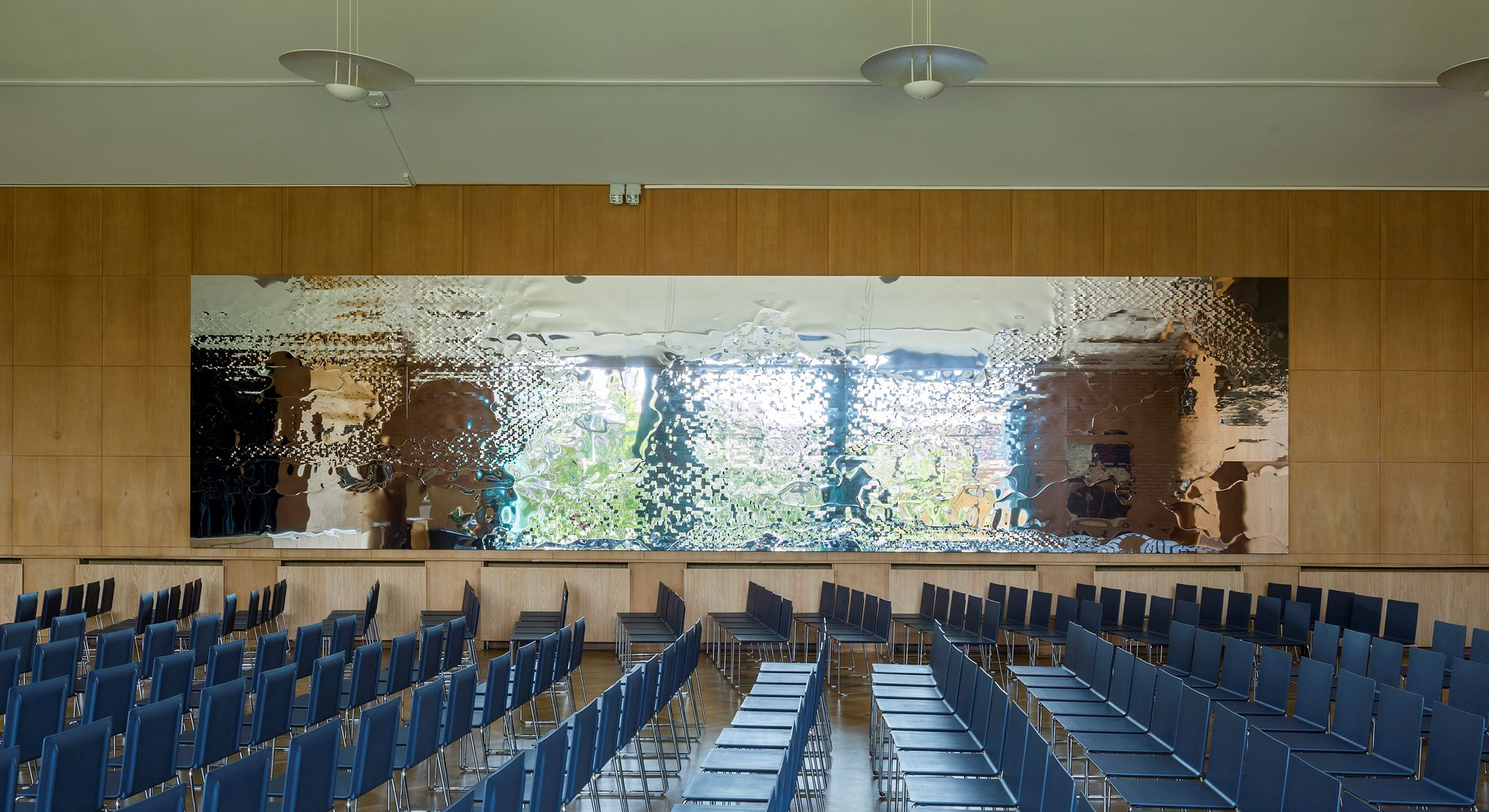Astrid Krogh is fascinated with the patterns and phenomena of nature, which catch her attention, sharpen her senses and keep her grounded in a feeling of being a part of something bigger.
Her artistic practice aims to capture and convey nature’s chancing character in works created for everyday architecture: the constant variations in nature’s patterns as the colours of the sky flow into one another, the infinity of the universe or the force of the wind that disturbs the wave pattern on the sandy seabed when it strikes the water’s surface.
Astrid Krogh has created a large number of commissioned artworks for the public space, often in prominent locations in Denmark and abroad. In this interview, she describes how her background as a weaver and textile designer is manifested in works of art that connect us, as human beings, to a world that is bigger than us.
Renewing tradition
A curious mind, an urge to experiment and an ambition to create her own unique expression has driven Astrid Krogh to develop an original artistic practice based on the textile designer’s methods.
‘From the outset, I have wanted to explore how I can use old techniques and new materials to create something new. That has been my take. So I used fibre optics on the old loom. Figuring out how to weave with them became my “thing”, but in fact, it’s the same process that has been used for centuries to weave wool and silk,’ she explains.
Since graduating as a textile designer and weaver from The Danish Design School (now The Royal Danish Academy – Design) in 1997, Astrid Krogh has challenged the boundaries of her field, particularly the pattern repeat, the basic unit that generates textile patterns through systematic repetitions. Her aim is to create patterns like those found in nature, where the structure varies and catch our eye, ‘because we can’t figure it out’.
Siden hun i 1997 tog afgang som tekstildesigner og væver fra Danmarks Designskole, i dag kaldet Det Kongelige Akademi – Design, har Astrid Krogh udfordret sit fags grænser. Særligt rapporten, tekstilets mønsterenhed, som genererer mønstre med systematiske gentagelser. I stedet vil hun skabe mønstre ligesom naturens, hvor strukturen varierer og holder blikket fast ”fordi vi ikke kan regne det ud”.
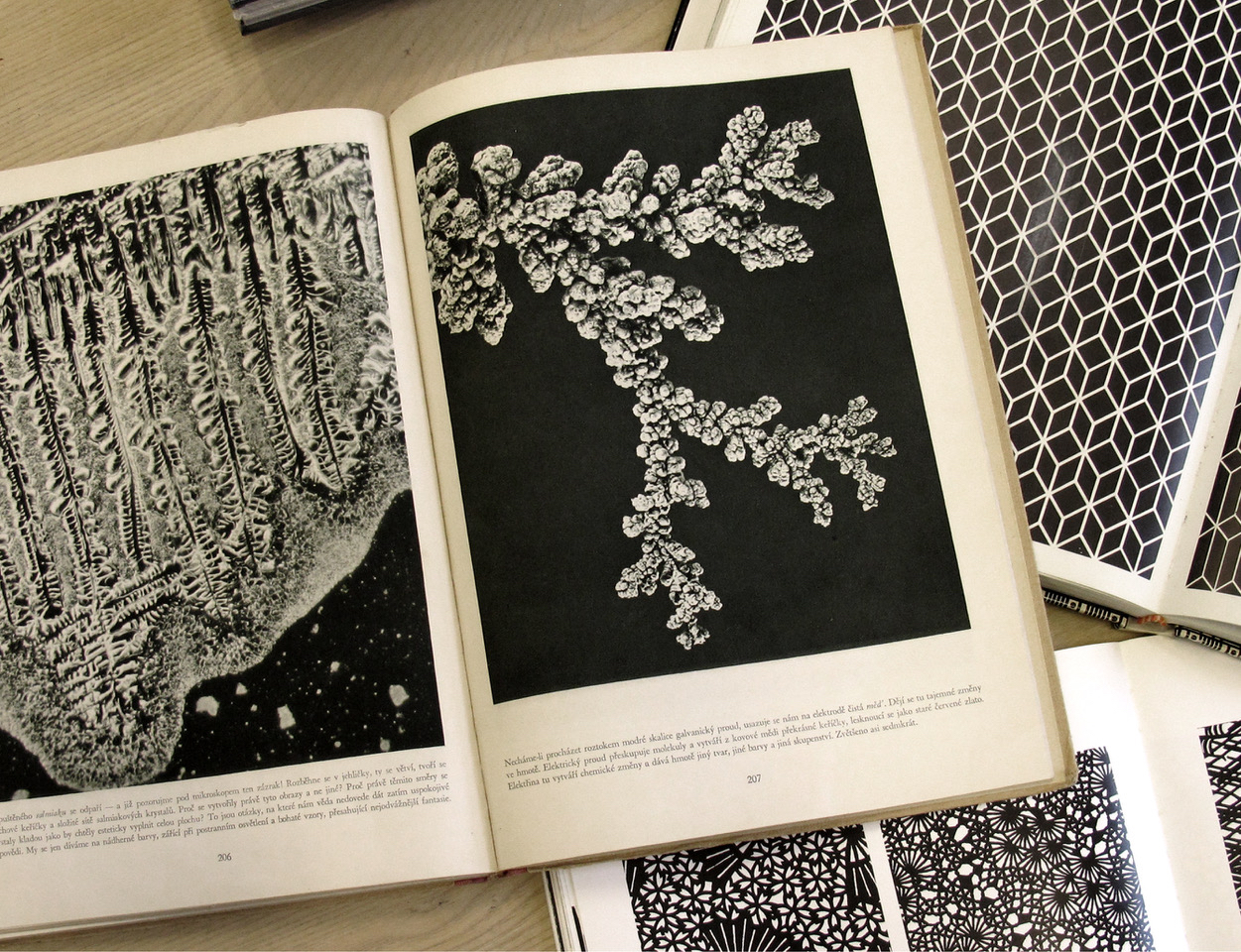
‘All textile is about order. When you set up a loom, you have to figure this order out, because that is what enables you to create – and I have always wanted to see how I can establish an order that I can then break and instead create “a recognizable order”, as I call it. Often, I have to start somewhere familiar. So I start with patterns I know. For example, if I want to make a pattern that expresses a sense of infinity, I start with elements I’m familiar with and stick to them for a long time, until I figure out how I can challenge them,’ she says.
One of Astrid Krogh’s methods is to combine traditional weaving techniques with new materials. In her first piece, Lightmail, from 2000, she wove a modern tapestry in optic fibres that glowed in a constant colour flow and made her known for ‘weaving with light’. In other pieces, Astrid Krogh tests the textural qualities of materials and the colour spectrum that the daylight brings out.
‘It is important to me to give the material a voice. Aluminium, for example – how can I make the most of the material itself without adding anything else?’ she says and describes her process for the work series Cloud Illusions:
‘I could have chosen to print a colour on the metal, but I wanted to see how I could make the material as reflective as possible. The imprint disturbs the mirror-like surface, so I began to perforate and brush it in order to disturb the order of the “mirror”. However, before it arrived at the simplicity it now has, I had applied paint and tried all sorts of other things,’ she says.
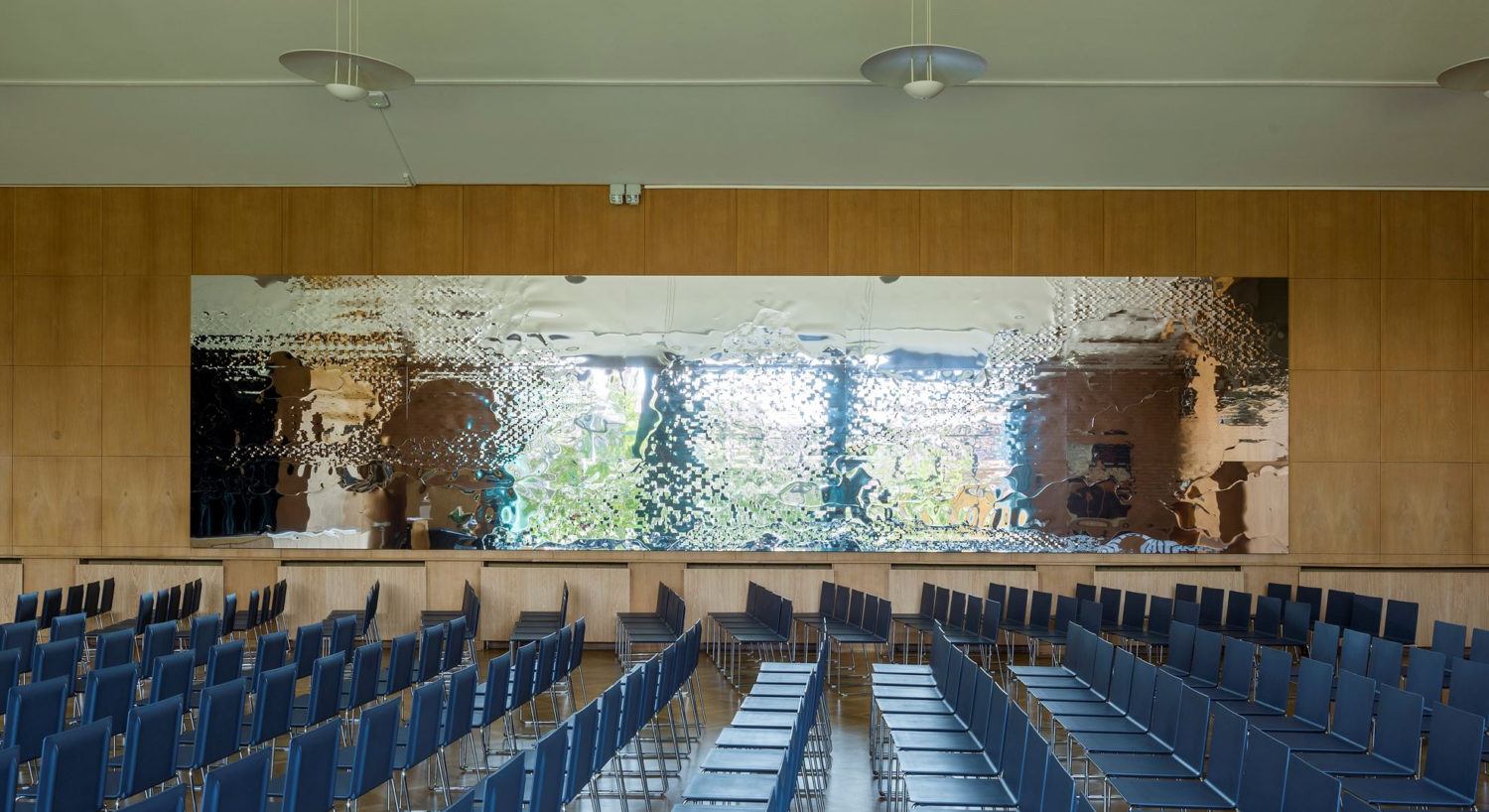
Stories from nature
Astrid Krogh’s approach to decorative projects springs from her crafts background, with its emphasis on understanding material properties. She often draws on her extensive vocabulary of materials and techniques from experiments and works of art. It is also natural for her to consider the possible functional aspects of a decorative project and its interplay with the architecture.
Often, a decorative project has to meet requirements for lighting or acoustic regulation. In one of her first commissioned projects, in 1999, she developed interior sunshades in laminated fibreglass for the offices at the Royal Danish Library on Copenhagen’s harbour front. In Dansk Kunsthåndværk no. 1, 1999 she describes how she aims ‘to do justice to the architecture’ and allow the material to create poetry in an interplay with the daylight.
‘Fiberglass’s qualities as a “hard-core” high-tech product that has the fragility of paper contrast with the building’s other materials. At the same time, fiberglass that has been given a surface treatment and laminated is able to filter out bright sunlight and the reflections of the water in steel and glass just enough to retain a certain transparency to the lovely surroundings,’ she wrote.
Today, Astrid Krogh still approaches art as an element that changes the ambience of an architectural space. Over the past two decades, she has created a many decorative projects in Denmark and abroad, often as commissions won in international competitions. In each case, she searches for an approach that will interweave her own story with that of the site itself and shape the atmosphere.
‘It’s hard to say what that takes. It’s a mix of grasping the site, sensing it and having an idea about what I can bring. I want to add something new, but to me, the new element is built on a layer of stories and a layer of materials that I have worked with before – and maybe I’ll combine them or maybe I’ll find an entirely new material,’ she says.
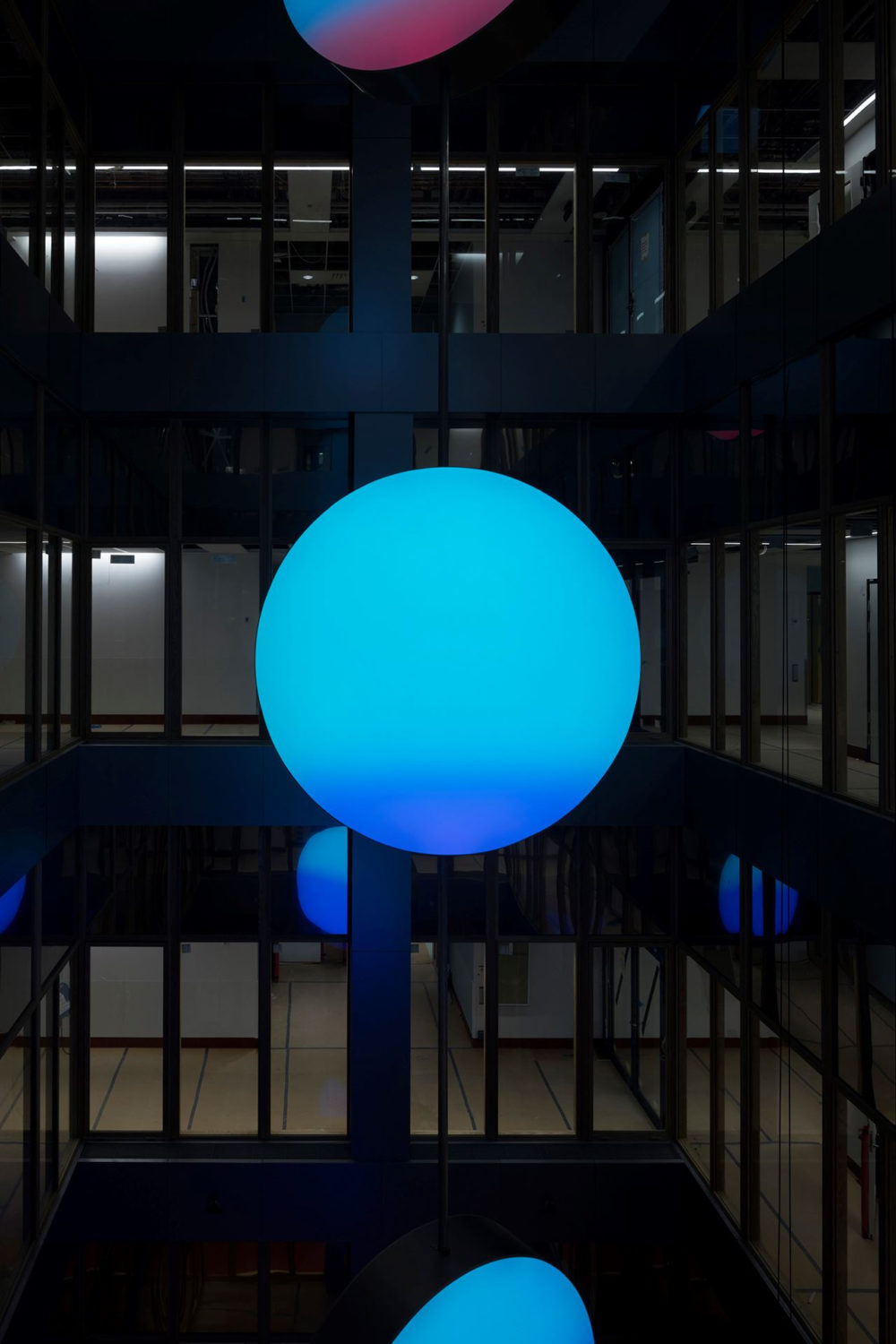
Often, natural phenomena inspire the stories Astrid Krogh embeds in her decorative projects. Like a sunrise that overwhelms her. One early morning when she saw the sun rise above the sea and saw the colours in the sky change faintly, almost meditatively, from deep black to orange, turquoise blue, violet, luminous gold, pale yellow and, finally, a pale blue, over a period of twenty minutes. It is this changing character she seeks to capture in her art.
‘That is what it’s all been about, and I think that’s why I find that changes heighten my own attention. But then I always discover that I can’t capture it. Or, I can capture aspects of it, so in a way, it’s a lot of partial stories. The story that morning … It came to me while I was working on “Skylight” with the large luminous discs that change colour,’ she says.
The universal human element
Sky and light are recurring features in Astrid Krogh’s stories when she enhances a space with the atmosphere the site calls for. At the large Danish hospital Rigshospitalet in Copenhagen, Astrid Krogh has created a window to the outside world in a chapel without daylight with a piece titled Lysvæld: A Breath of Light.
‘When I first saw the space, I thought, there has to be a glimpse of the sky. That is so fundamental to church architecture, so I was very conscious of the need to bring that back,’ she says.
The gold-plated altarpiece emits a warm, golden light in the small, compact room and imbues the space with the sense of reverence and calm associated with a church. Here, patients and relatives mourn, pray and hope at a critical time in their life. In the visitors’ book, parents write birthday greetings to children who have passed away, and many thank God, while others are gripped, in particular, by the atmosphere of the space.
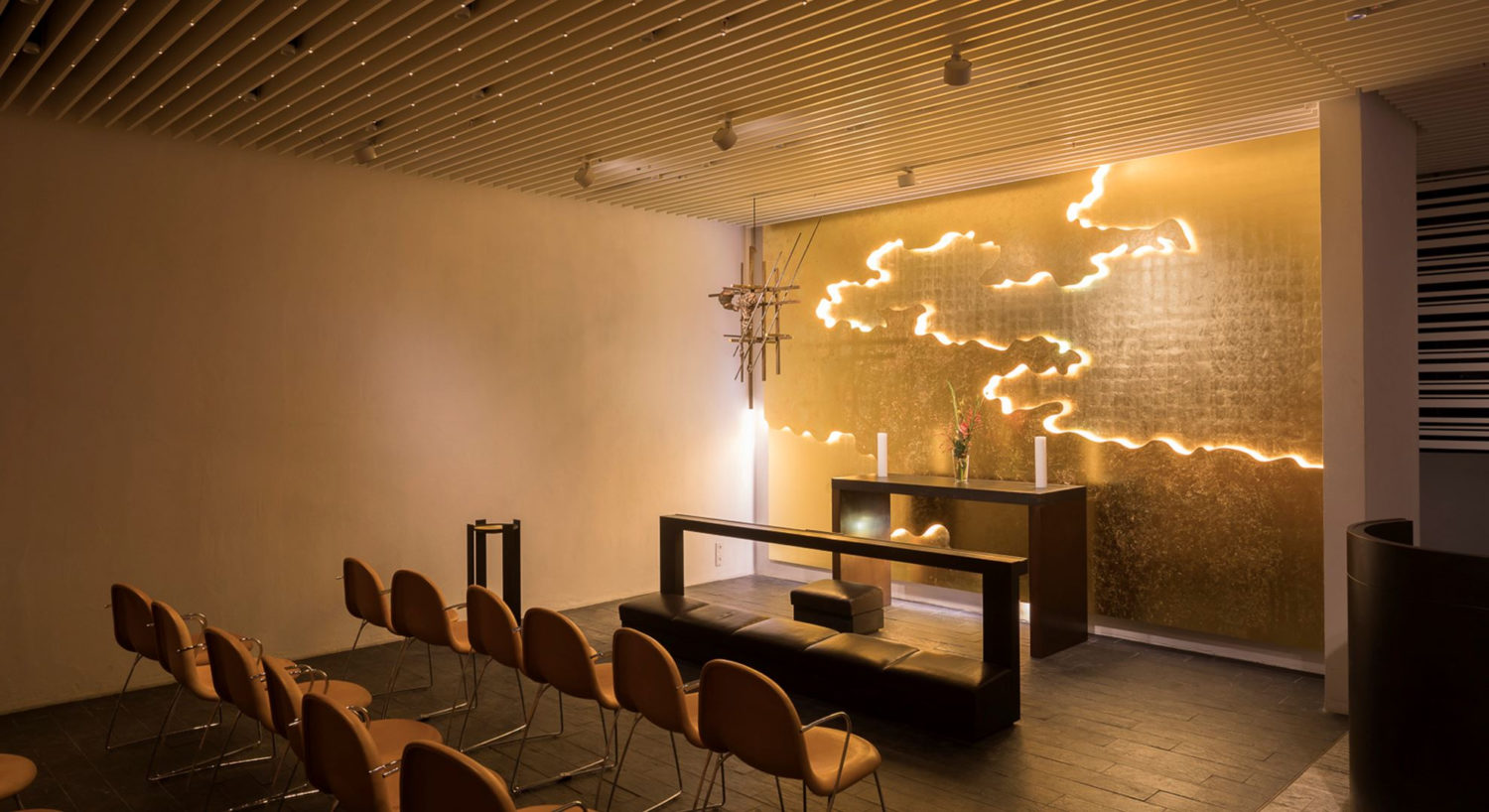
‘Once, when I came into the chapel, a woman was standing with her arms raised up over head, leaning towards the altarpiece. As if she sought to soak up some of that golden light,’ she says, as she demonstrates by standing up, arms raised, eyes half closed.
When darkness falls, the golden light flows into Corridor 5.00.1 with its granite, concrete, glass and grey painted steel surfaces. As people walk by on their way to the blood test clinic, the EKG lab or the toilet, a metaphysical crack appears in the machine that Denmark’s biggest hospital also is, and right here, where life is put into relief, the encounter with a natural phenomenon makes a real difference.
‘In my opinion, creating art for the public space comes with a responsibility to find something with a universal human appeal, something that most people will be able to tap into. Certain phenomena are intuitively comprehensible – like a sunrise, with its golden light. It puts us in a state that reminds us how tiny we are. It folds its wings around us, saying, “Relax! You’re just a tiny speck,” and I think that’s probably a good thing for us, as human beings, to be reminded of,’ says Astrid Krogh.
Artist and designer Astrid Krogh (b. 1968) graduated as a textile designer from The Danish Design School in 1997 (now The Royal Danish Academy – Design). Since 1999 she has created decorative projects for public and private clients in Denmark and abroad, including the Danish Parliament, the Royal Danish Library, Maersk Data, New Karolinska University Hospital Solna (Sweden) and Halden Prison (Norway). Among other accolades, she has received the Thorvald Bindesbøll Medal (2008), Danmarks Nationalbank’s Honorary Grant (2015) and the Finn Juhl Prize (2016) for her artistic practice.
Tyra Dokkedahl is a journalist and architect specializing in decorative projects and identity of site. She is the owner of Seriously Fun, an agency advising public and private clients on art and communication in the built environment.

